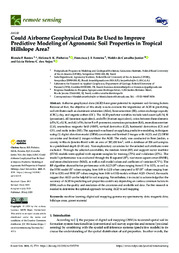Could airborne geophysical data be used to improve predictive modeling of agronomic soil properties in tropical hillslope area?
Could airborne geophysical data be used to improve predictive modeling of agronomic soil properties in tropical hillslope area?
Author(s): BASTOS, B. P.; PINHEIRO, H. S. K.; FERREIRA, F. J. F.; CARVALHO JUNIOR, W. de; ANJOS, L. H. C. dos
Summary: Airborne geophysical data (AGD) have great potential to represent soil-forming factors. Because of that, the objective of this study was to evaluate the importance of AGD in predicting soil attributes such as aluminum saturation (ASat), base saturation (BS), cation exchange capacity (CEC), clay, and organic carbon (OC). The AGD predictor variables include total count (uR/h), K (potassium), eU (uranium equivalent), and eTh (thorium equivalent), ratios between these elements (eTh/K, eU/K, and eU/eTh), factor F or F-parameter, anomalous potassium (Kd), anomalous uranium (Ud), anomalous magnetic field (AMF), vertical derivative (GZ), horizontal derivatives (GX and GY), and mafic index (MI). The approach was based on applying predictive modeling techniques using (1) digital elevation model (DEM) covariates and Sentinel-2 images with AGD; and (2) DEM covariates and Sentinel-2 images without the AGD. The study was conducted in Bom Jardim, a county in Rio de Janeiro-Brazil with an area of 382,430 km², with a database of 208 soil samples to a predefined depth (0-30 cm). Non-explanatory covariates for the selected soil attributes were excluded. Through the selected covariables, the random forest (RF) and support vector machine (SVM) models were applied with separate samples for training (75%) and validation (25%). The model's performance was evaluated through the R-squared (R2), root mean square error (RMSE), and mean absolute error (MAE), as well as null model values and coefficient of variation (CV%). The RF algorithm showed better performance with AGD (R2 values ranging from 0.15 to 0.23), as well as the SVM model (R2 values ranging from 0.08 to 0.23) when compared to RF (R2 values ranging from 0.10 to 0.20) and SVM (R2 values ranging from 0.04 to 0.10) models without AGD. Overall, the results suggest that AGD can be helpful for soil mapping. Nevertheless, it is crucial to acknowledge that the accuracy of AGD in predicting soil properties could vary depending on various common factors in DSM, such as the quality and resolution of the covariates and available soil data. Further research is needed to determine the optimal approach for using AGD in soil mapping.
Publication year: 2023
Types of publication: Journal article
Unit: Embrapa Soils
Observation
Some of Embrapa's publications are published as ePub files. To read them, use or download one of the following free software options to your computer or mobile device. Android: Google Play Books; IOS: iBooks; Windows and Linux: Calibre.
Access other publications
Access the Agricultural Research Database (BDPA) to consult Embrapa's full library collection and records.
Visit Embrapa Bookstore to purchase books and other publications sold by Embrapa.

